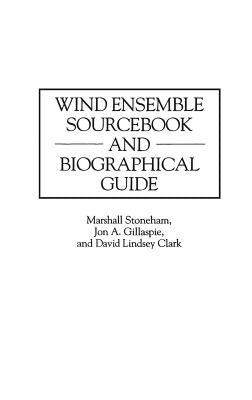Before you leave...
Take 20% off your first order
20% off
Enter the code below at checkout to get 20% off your first order
Discover summer reading lists for all ages & interests!
Find Your Next Read

Mozart wrote some of the greatest serenades for wind ensemble. He was not alone in writing works for wind sextet, octet, or larger ensembles--Over 12,000 works for wind harmony by over 2,200 composers are extant. Describing this new genre, Wind Harmony, which is far larger and more influential than ever recognized, this sourcebook includes biographical details, discusses many of the works, and presents country surveys. There is also a survey of the way wind instruments developed at the critical time, and of performance practices. Companion volumes, the IWind Ensemble Catalog R and the IWind Ensemble Thematic Catalog 1700-1900 R, are cross-referenced.
Mozart wrote some of the greatest serenades for wind ensemble. He was not alone in writing works for wind sextet, octet, or larger ensembles--over 12,000 works for wind harmony by over 2,200 composers are extant. Describing this new genre, Wind Harmony, which is far larger and more influential than ever recognized, this sourcebook includes biographical details, discusses many of the works, and presents country surveys. There is also a survey of the way wind instruments developed at the critical time, and of performance practices. Companion volumes, the IWind Ensemble Catalog R and the IWind Ensemble Thematic Catalog 1700-1900 R, are cross-referenced. The authors identify what must be the major part of surviving wind harmony music. There is far more material than previously recognized, and its character is far more varied than is usually thought. In this work, the music is placed in context: why it was written, where it was played, and how it influenced other genres. The authors have collected new material, corrected previous mistakes, and filled in missing material. Public and private libraries have been scoured and monasteries searched throughout greater Europe. The sourcebook will be helpful for scholars and students, librarians, players, and music sellers.MARSHALL STONEHAM is Massey Professor of Physics, University College London, a Fellow of the Royal Society, and Chief Scientist of AEA Technology. He has written extensively not only on the physical sciences, but on music as well. He has taken the opportunity to visit libraries in many countries when on travels associated with his scientific work. He is an experienced horn player and the founder and organizer of the Dorchester Wind Players, which, over the past twenty years, has played many works of the genre described in this book.
JON A. GILLASPIE is a freelance musicologist and music cataloger as well as a composer, arranger, record producer, and experienced bassoonist and keyboard player. Born in Potsdam, New York, he studied social anthropology before emigrating to England in 1973. His extensive travels researching into primary sources of wind harmony now total more than three actual years in the field and his own extensive collection includes the former wind harmony of the Dowenstein Kapelle. He has composed and arranged widely for wind ensemble, including many works for the Dorchester Wind Players. DAVID LINDSEY CLARK was a Music Librarian to Oxfordshire County Libraries, Oxford, England. He has been involved in the revision of the Music Catalogs of a number of libraries, including the Bodleian of Oxford University. Now retired, he continues his bibliographical work, reflecting his interest in exploring the repertoire of music on which he has written over a number of years.Thanks for subscribing!
This email has been registered!
Take 20% off your first order
Enter the code below at checkout to get 20% off your first order